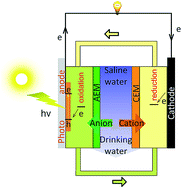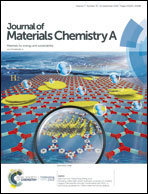Exploration of a photo-redox desalination generator†
Abstract
Two of the greatest global challenges faced by humankind in the 21st century are (1) the lack of access to a clean and potable water supply, and (2) the need for sustainable energy. As such, scientists from all subject areas have been actively developing methods to solve water shortages and the energy crisis. Herein, we present a photo-redox catalysis desalination generator, which possesses dual functions, acting as both an efficient salt remover and a dye-sensitized solar cell (DSSC)-based photoelectricity energy converter. It consists of dye semiconductor materials, a recirculating redox flow electrolyte between the anode and cathode, and salt feed streams. It utilizes the redox reaction of the electrolyte driven by the photo-excited semiconductor and simultaneously, it captures the salt anions and cations via coupling in the presence of ion exchange membranes. The cell is proposed to possess an unlimited salt removal capacity due to the redox catalysis of the same electrolyte redox species, while energy can be released via photoelectric energy conversion. This method will bypass the limitations of energy consumption in desalination and effectively solve the two major issues outlined. The current research will revolutionize desalination methods and propel desalination to a new era.



 Please wait while we load your content...
Please wait while we load your content...